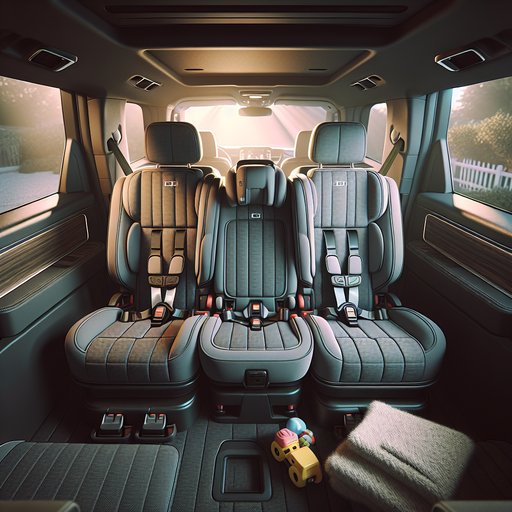
We fitted two ISOFIX/LATCH child seats plus a belt-positioning booster across the second-row bench of a 2024 Volkswagen Atlas SEL 4Motion to evaluate anchor access, belt routes, and rear-door opening practicality for everyday family use.
Our test vehicle was a refreshed 2024 Atlas with the 2.0 TSI (269 hp, 273 lb-ft) and the second-row bench. The Atlas is one of the roomier midsize SUVs, and VW markets it toward families, so three-across is a reasonable expectation. We used a Clek Fllo (rear-facing) and a Britax One4Life (forward-facing) for the LATCH installs, plus a Graco TurboBooster LX (high-back) in the center using the vehicle belt. Weather was mild, and we tested over a week of school runs and errands, reinstalling multiple times on level pavement.
The Atlas provides two sets of lower anchors in the outboard positions and three clearly labeled top tether anchors across the second row. The center seat does not have dedicated lower anchors, so the booster (or any center harnessed seat) must use the seat belt; a top tether is available for a forward-facing harnessed seat in the center. Anchor access is excellent thanks to rigid plastic guides that sit flush with the seat bight—no fishing required. Both child seats latched to the outboard ISOFIX/LATCH bars quickly, with positive clicks and minimal trim interference.
The Fllo’s anti-rebound bar cleared the seatback cleanly, and the One4Life’s top tether routed straight to the seatback anchor without crossing headrests. Note: always confirm combined LATCH weight limits in the vehicle and child-seat manuals; our installs were within manufacturer limits. With both outboard seats snugged to less than 1 inch of movement at the belt path, we still had a usable center position for the booster. The center booster fit is better than average.
The Atlas’s buckle stalks are short and semi-rigid, so they don’t fold under load (reducing buckle crunch), yet they sit high enough for small hands to access between the two installed seats. The shoulder belt lays flat across the dummy’s collarbone without rubbing the adjacent child-seat shells. The center headrest is adjustable and didn’t force the booster forward; no removal was necessary to achieve a flush seatback. Rear-door access is a strong point.
The Atlas’s rear doors open wide enough to swing a bulky rear-facing seat in without gymnastics, and the door aperture is tall with a low sill, which helps when loading toddlers. With the rear-facing Fllo behind the passenger, we could still set the front seat for a 5'11" driver comfortably. Seat belts use switchable locking retractors, so belt installs (if you choose them to eke out a little extra width versus LATCH) are straightforward. In daily use, buckling the center booster requires a deliberate reach but is workable; choosing narrow-profile seats (Clek/Diono-type) preserves crucial finger room.
If your two primary seats are wider, consider seat-belt installs outboard to shift them outward a few millimeters, or move the booster to the third row. Overall, the Atlas passes the two LATCH seats plus center booster test with easy anchor access, clean belt routes, and family-friendly door geometry—an excellent choice for growing families.












